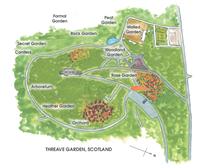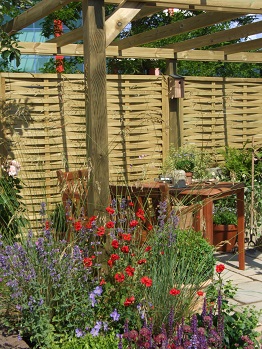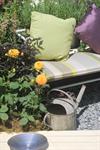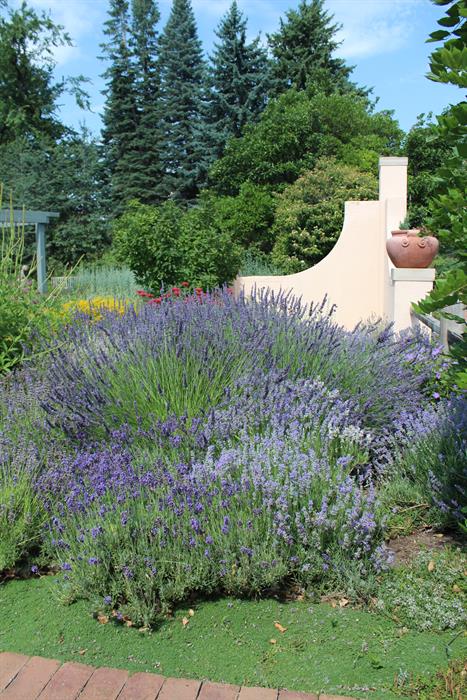
Study and Learn Cottage Garden Design
There is something exquisitely beautiful about a well designed cottage garden. Learn the art and craft of good design so you can include cottage gardens amongst your offerings. Find out what a proper cottage garden is, and how to apply the principles of this concept to garden design and garden renovation.
Add to your garden design repertoire
This is an ideal course for people with an interest in landscape design. Develop the skills to feel confident offering cottage garden design or restoration as part of your landscaping service.
- Explore the diverse range of both plants and hard landscape materials that can be used in a cottage garden.
- Be guided by our team of experienced garden designers and plants specialists, qualified and experienced in all aspects of landscaping and horticulture, who make up our horticulture faculty.
- Commence studies any time of the year, working at your own pace and from wherever it best suits you to study (even while traveling if you so choose).
What is a Cottage Garden?
Mary Davis, in her 1993 book "Creating Cottage Gardens", says: "It is best described as a profusion of flowers, particularly perennials, closely planted for a very soft effect. A cottage garden will usually include such delights as lavenders, daisies and old fashioned roses. It's style is informal, a medley of soft shapes and harmonious colours..... "
Course Structure

There are 8 lessons in this course:
- Introduction To Cottage Gardens
- History Of Cottage Gardens
- Design Techniques and Drawing Plans
- Plants For Cottage Gardens
- Planting Design In Cottage Gardens
- Landscape Features and Components
- Cottage Gardens Today
- Special Assignment - Design Of A Complete Garden.
On successful completion of the course you should be able to do the following:
- Explain the concept of a cottage garden.
- Prepare concept plans for cottage gardens.
- Prepare planting designs for cottage gardens.
- Plan the incorporation of appropriate non-living landscape features in a cottage garden.
- Prepare a detailed design for a cottage garden.
Here are just some of the things you will be doing:
- Explain the concept of a cottage garden, both in historical and modern contexts.
- Explain the influence of one famous landscaper on cottage gardens.
- Explain the relevance of garden design concepts to cottage gardens, including: *Unity *Balance *Proportion *Harmony *Contrast *Rhythm *Line *Form *Mass *Space *Texture *Colour *Tone.
- Analyse the designs of three cottage gardens inspected by you.
- Describe the steps involved, accompanied by a sequence of illustrations, in the planning process for a cottage garden.
- Develop a check list of pre-planning information required for a proposed cottage garden on a specific site.
- Compile pre-planning information for a specific site, for a proposed cottage garden, through an interview with a potential client, and surveying the site.
- Prepare drawings to represent landscape features on a cottage garden plan, including trees, shrubs, herbs, walls, rocks, buildings and other landscape features.
- Analyse the designs of three different cottage gardens, inspected by you.
- Prepare three different cottage garden concept plans for the same site, to satisfy given design specifications and pre-planning information.
- Prepare a plant collection of fifty-cottage garden plants, which includes: *A photo, drawing or pressed specimen of each plant *Plant names (scientific and common) *Cultural details *Uses/applications in garden design.
- Prepare a planting plan for a garden bed of 20 to 30 square metres in a cottage garden style, including: *A sketch plan *A plant list.
- Design a perennial border of 30 metres in length, in an appropriate cottage garden style.
- Design a 50 to 100 square metre garden bed, which incorporates companion planting principles.
- Evaluate the companion planting design in a cottage garden visited by you.
- Design a colour themed garden, such as a white garden, for an area of 200 square metres or less, to suit a proposed garden redevelopment, on a site visited by you.
- Describe briefly, different non-living features that may be included in a cottage garden, including: *Seating alternatives *Bird baths *Sun dials *Fountains *Statues
- *Pergolas *Gazebos *Fencing *Ponds *Weather vanes.
- Determine criteria for inclusion of different landscape features in a cottage garden, including: *Gazebos *Ornaments *Arbors *Tub plants *Water features *Paths.
- Compare the characteristics, including: *Suitability for a cottage garden *Cost *Availability *Longevity *Appearance *Maintenance, of different landscape materials.
- Explain the use of plant sculpting, including topiary and hedging, in cottage garden designs; including references to: *Ways of creating it *Ways of using it *Maintenance.
- Analyse, in a report including photographs, the use of different structures as features, in the designs of two different cottage gardens, visited by you.
- Prepare three cottage garden concept plans, one each for different specified sites, which incorporate different types of features sympathetic to cottage or heritage gardens.
- Develop a brief for a cottage garden design, for the redevelopment of an established garden around an old building in your locality.
- Analyse the designs of two different well established cottage gardens visited by you.
- Compile pre-planning information for a specified cottage garden development.
- Prepare detailed plans for a cottage garden (following industry standards), including:
- *Detailed plans *Materials lists *Costings.
- Explain the reasoning behind a cottage garden designed by you.

WHAT TO PLANT IN A COTTAGE GARDEN?
Traditionally cottage gardens were a random mixture of useful and ornamental plants, with more emphasis being given to the useful plants which for instance; could be eaten, used for medicinal purposes, or as animal forage. The ornamental plants were an afterthought, using colourful and easily grown annuals, herbaceous perennials and small shrubs to brighten the garden, space permitting.
These days the best cottage gardens are carefully designed to give a pleasing arrangement of ornamental plants, herbs, vegetables, garden ornaments and accessories.
Cottage plants are generally chosen with more forethought, although colour and abundance are still the most important features. Anyone can throw down a handful of seeds and within a few weeks have a wildly profuse and colourful bed of poppies, hollyhocks, nasturtiums and the like, but it takes rather more planning to create a cottage garden that looks charming throughout the year.
- Dense plantings - using fast-growing annuals and herbaceous perennials will help to create the effect quicker.
- Self-seeding plants – these are used to perpetuate the effect. Use plants such as Myosotis (Forget-me-nots), Escholtzia californica (Californian poppies), Lobularia maritima (alyssum), Lychnis coronaria (rose campion), Tropaeolum majus (nasturtium) and Viola betonicifolia.
- Scented plants – bring fragrance into a garden and stimulate the senses.
- Contrasting foliage plants – provides an avenue to produce focal points and places of interest.
- Lawns are kept to a minimum – this allows maximum use of flowering plants and garden ornaments.
- Climbers – these are used to screen sheds, fences, other bad views, etc.
- The front garden is designed to showcase the plants right to the street.
Within these broad guidelines, gardening styles vary greatly. Some cottage gardeners like neatly mulched beds with colour co-ordinated plantings; others like their garden to be functional, growing herbs and vegetables among the ornamental plants; and yet others prefer the romantic, slightly unkempt look, which is easily attained with cottage plants.

Opportunities After Study
This course may be studied by itself or along with other modules as part of a higher level qualification.
It is of value to people wishing to work in:
Garden design
Garden restoration
Landscaping
Garden maintenance
Parks & gardens
Horticulture
Education
Research